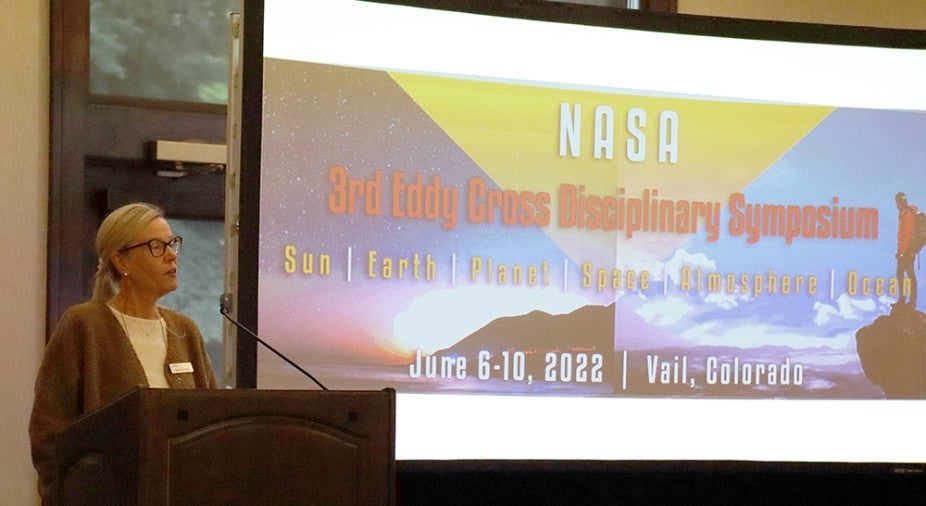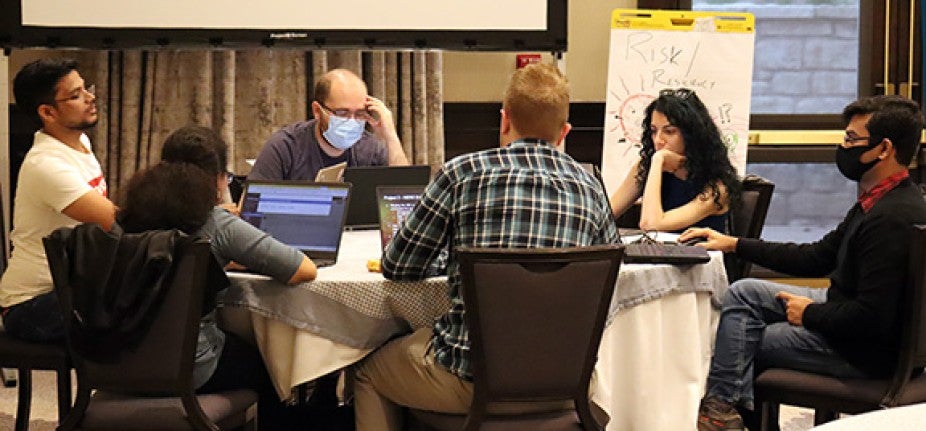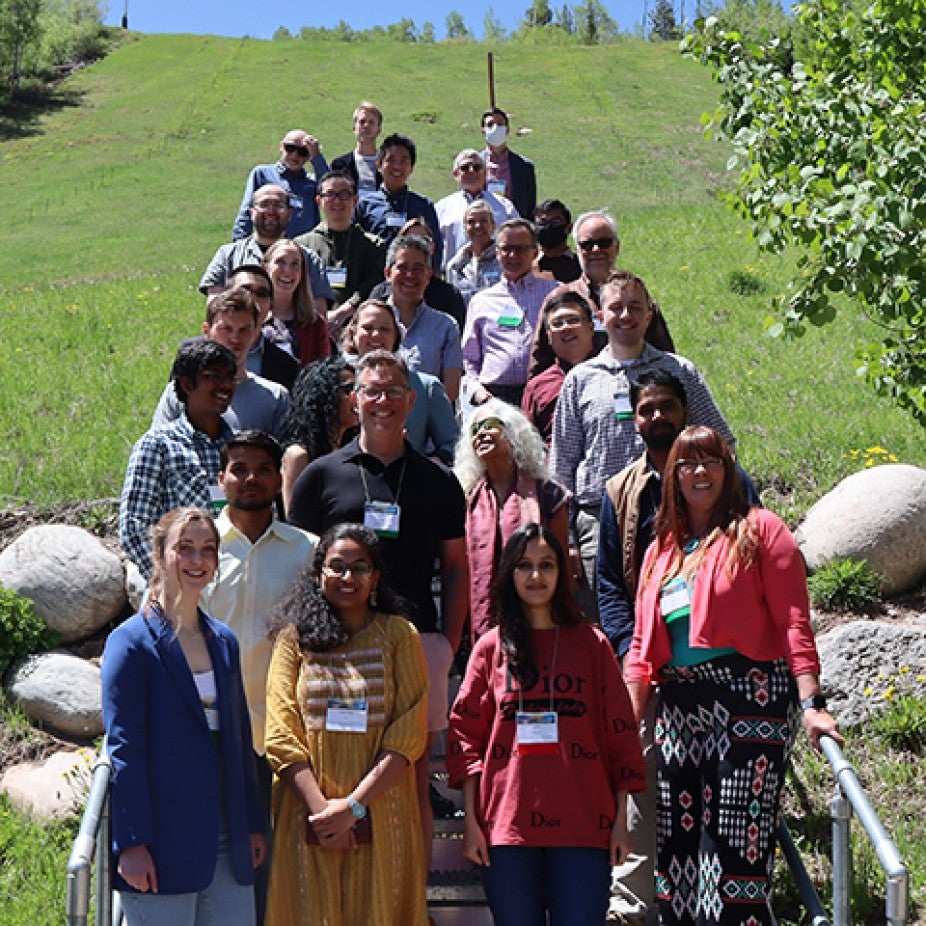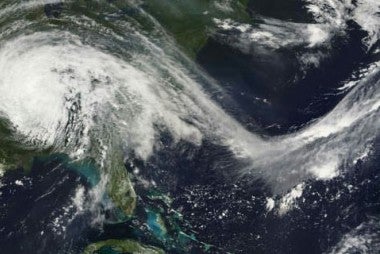3rd Eddy Symposium: Stellar Collaborations
The purpose of the 3rd Eddy Cross Disciplinary Symposium was to convene diverse experts in geosciences, astrophysics, data science, and heliophysics with scientists worldwide to identify areas ripe for harvesting the rewards of decades of research studies in this era of Big Data and the challenges that need to be overcome. The symposium focused on processes in connected systems such as Sun-Earth relations, weather-climate connections, and novel star-planet interactions.
The overarching theme of the 3rd Eddy Symposium is Why Grand Challenges in Solar Terrestrial Physics Require Open Science? with a special light shown on Open Science Methods: Emerging Open Science Methodologies.

SPS and CPAESS Director Hanne Mauriello opens the 3rd Eddy Symposium, welcoming attendees from across the globe.
Spearheading this symposium, as well as CPAESS’ other educational partnerships with NASA, was Dr. Madhulika “Lika” Guhathakurta of NASA Headquarters. Lika is truly a visionary when it comes to the field of heliophysics and its interconnectedness with other sciences. With the steering committee she helped create this unique gathering of experts in diverse but related fields, along with young scientists embarking upon their careers in heliophysics. Of the symposium she says, “[We] bring scientists, engineers, data analysts from various disciplines [together] so that we are not siloed…we work at the intersection of the science boundaries to figure out new science and make new discoveries.”
WATCH MORE about the 3rd Eddy Symposium

Left to Right: Director of the NASA Goddard Institute GavinSchmidt, NASA Heliophysics Division Program Scientist Simon Plunkett, NASA "Living With a Star" Lead Program Scientist Madhulika Guhathakurta, and SPS Center and CPAESS Director Hanne Mauriello.
The sessions on Monday through Thursday consisted of morning plenary talks where experts reviewed opportunities in science, engineering and computer science with plenary presentations. The topics ranged across the spectrum of the interdisciplinary field of heliophysics with discussions on SDO Machine Learning Dataset (Meng Jin, Lockheed Martin Solar & Astrophysics Laboratory|SETI Institute) to Challenges, opportunities and tips for young scientists (Phillip Judge, NCAR High Altitude Observatory).
Emergency Management database information was discussed in Ilkay Altintas, University of California, San Diego’s presentation on WIFIRE Commons: An Open Data and Model Cyberinfrastructure for Wildland Fire Science and Solutions, as well as an update from Richa Naja Jain, Vikram Sarabhai Space Center, ISRO on the Results from Radio sounding of Solar Corona conducted by Indian Mars Orbiter Mission (MOM). Hazel Bain of CIRES/ University of Colorado, Boulder and the NOAA Space Weather Prediction Center presented on Space Weather: Research, Operations, and Users. The variety of topics covered in these talks was truly vast.
For example, in the beginning of the week, student Vincent Ledvina of the University of North Dakota presented on The North Dakota Dual Aurora Camera (NoDDAC), a student-led citizen science project and open-data resource for scientific and public communities to study mid-latitude auroras. Later in the week, Elizabeth MacDonald, a NASA Space Physicist who founded the Aurorasaurus platform and has been working with the Alberta Aurora Chaser (citizen scientist program) also presented about this effort.
There is an astronomical phenomenon “similar to their more well-known cousins Aurora Borealis and Australis” called STEVE which stands for Strong Thermal Emission Velocity Enhancement (STEVE). These purple and green lights are caused by “a ribbon of hot gases rather than particles like electrons and protons like the auroras.” Elizabeth wrapped up her presentation with the movie on this project called Chasing Steve.
Each afternoon, sessions were spent in smaller groups working on exploring novel open science methods to explore pressing questions in focused working groups. Each working group brainstormed on how to generate progress in three particular focus areas: the Interconnection of Sun, Climate, and Society; Risk and Resiliency to Space Weather Disruption; and (Exo)Planetary Atmosphere: the Impact of Stars and Solar Physics on Habitability and Life. These sessions gathered unique groups of scientists together whose expertise fell into these arenas. Here is a general overview of each working group's purview.
- The Interconnection of Sun, Climate, and Society - This theme focused on a systems science approach to the Solar-Terrestrial connection, encompassing the immense range of spatial and temporal scales (from micro to system-wide, and from instantaneous to climatological) and their impacts. In centering the systems aspect of Earth System Science they explored far-reaching interconnections within solar-terrestrial physics, including two-way connections to climate and society.
- Risk and Resiliency to Space Weather Disruption - Focus on the complex interactions of the solar cloud of plasma with the near Earth space and terrestrial environment – “space weather” – holds tangible implications to our global, technological, and space-faring society. Heliophysics research faces a challenge and an exigent imperative to connect academia, industry, government, and end-users to together build societal resilience to the grand challenges that space weather poses. This theme explored how space weather understanding and preparedness can be addressed through risk and resilience frameworks.
- (Exo)Planetary Atmosphere: the Impact of Stars and Solar Physics on Habitability and Life - The study of solar-terrestrial interactions has relevance that extends far beyond that of furthering our understanding of what has led to and shapes the environment we humans operate in. Understanding a star's interaction with the space and planets that surround it is fundamental to planetary science, exoplanetary discovery and characterization, and habitability in the universe. This theme addressed a more capacious view of Heliophysics and attempted to understand the places in these interconnected disciplines where Heliophysics understanding must contribute.
Throughout these afternoon brainstorming sessions, a need for a Solar Climate center became apparent. So a hopeful outcome of this symposium will be more discussions in NASA on its possible development.

Risk and Resilience Working Group assessing ways to keep Earth safe
In between the plenaries and working groups was an impromptu Jupyter Hub training session by Fernando Perez, University of California Berkeley, and Jim Colliander, University of British Columbia, in which scientists were shown how to quickly draw from the data sets available through GitHub to scientists from all over. This session enabled the scientists to have a world of data accessible to them to compare and contrast for a variety of analyses.
From this organic cooperation and collaboration, the process of science itself sparked in a new way. For example, Jim Colliander with Fernando Perez - both co-founders of 2i2c - deployed a Jupyter Hub for the symposium. In providing technical support to participants, Jim received a question from Ph.D. candidate Greg Cooke on how to gain access to a NASA Exoplanet archive. Jim created a notebook to enable Greg to use this data. Dan Marsh, NCAR | University of Leeds who is Greg’s Ph.D. co-supervisor was helping Greg with his project on exoplanet atmospheres and whether they could hold onto their atmospheres as they orbit close to a star. As there is a good deal of uncertainty around this issue they wanted to test this, they took a global model and hit it with various solar spectra and decided to do so with the new tools and data they were given access to via Jupyter. As a result of this collaboration with Jim, Greg was able to create an open source tool that anyone could use where they could create star spectra scaled to different planets using the same methodology. Prior to this insight it had taken Greg 5 hours to do one planet, but with this new technology he can do 10 spectra in 5-10 minutes.
“I’m delighted to see what Dan and Greg have done in just the span of a couple of days in really moving forward and accelerating their ability to discover [answers] to the kinds of questions that their domain is asking with these tools that are open to everyone” exclaimed Fernando Perez of University of California at Berkeley and co-founder of Jupyter. This cooperation and sharing of knowledge enables science to progress more quickly. “Here we have a graduate student who was looking at one exoplanet, and then he started using the Jupyter notebook and got access to all the archival data of exoplanets from CalTech and now he can do comparative studies of exoplanets” explained Lika Guhathakurta of NASA Headquarters. It speaks to the power of sharing cross disciplinary knowledge to accelerate the speed of discovery.
Find out more about the 2i2c's assistance with at the 3rd Eddy Symposium, and how it transformed one student's Ph.D. research with this quick video on technical and intellectual collaboration.

Some of the attendees of the 3d Eddy Symposium gather for a photo in Vail, Colorado.
The Eddy Symposium Steering Committee included Dan Marsh (Co-chair), NCAR Atmospheric Chemistry Observations and Modeling Laboratory; Ryan McGranaghan (Co-chair), Orion Space Solutions, NASA Goddard Space Flight Center (contractor); Madhulika Guhathakurta, NASA Headquarters; Ankush Bhaskar, ISRO, Vikram Sarabhai Space Centre; Rajesh Gupta, Department of Computer Science and Engineering, University of California, San Diego; Meng Jin, Lockheed Martin; King-Fai Li, Department of Environmental Sciences, University of California, Riverside; and Erika Palmerio, Predictive Science Inc. Additionally numerous NASA Jack Eddy Fellowship alumni were speakers and participants including: Ankush Bhaskar, Chuanfei Dong, King-Fai Li, Meng Jin, Erika Palmerio, Andres Munoz-Jaramillo, and Ryan McGranaghan. Also in attendance was NOAA Climate and Global Change alumni, Gavin Schmidt who is now Director of the NASA Goddard Institute.
A great deal of comradery, respect, and mentoring was evident throughout the entire event. There were even a handful of doctoral and postdoctoral students who, with a former Jack Eddy Fellow Ankush Bhaskar, flew out for the event. Their trip from India, through Europe, into the United States, and the 2 hour drive from Denver International Airport to Vail took several of them about 48 hours. They each added a great deal to this experience through their presentations and participation, and we are most grateful for the tremendous effort they took to journey to the symposium.
While many countries were represented in both the presenters and attendees, Keshav Ram Tripathi encapsulated the feeling of international cooperation and collaboration nicely by saying that this whole experience reminded him of a Sanskrit phrase - Vasudhaiva Kutumbakam, which means “the world is one family.” Keshav generously offered that as the whole group was so friendly and welcoming, this Eddy Symposium gave him that feeling. So in spite of the fact that he flew all the way across the globe to get here, he felt at home.
Learn more about UCAR | CPAESS’ long relationship with NASA and our heliophysics work, which includes the NASA Jack Eddy Fellowship, the NASA Living With A Star Institute, Heliophysics Educational resources, and the NASA Heliophysics Summer School









